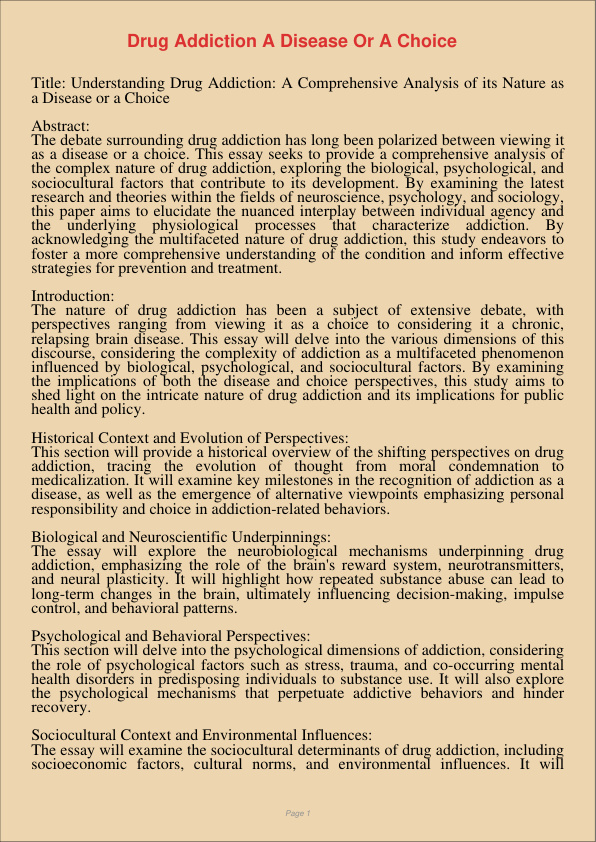Drug Addiction A Disease Or A Choice
Jan 9, 2024
drug addiction
disease
Other
Visual Arts & Film Studies

Title: Understanding Drug Addiction: A Comprehensive Analysis of its Nature as a Disease or a Choice
Abstract: The debate surrounding drug addiction has long been polarized between viewing it as a disease or a choice. This essay seeks to provide a comprehensive analysis of the complex nature of drug addiction, exploring the biological, psychological, and sociocultural factors that contribute to its development. By examining the latest research and theories within the fields of neuroscience, psychology, and sociology, this paper aims to elucidate the nuanced interplay between individual agency and the underlying physiological processes that characterize addiction. By acknowledging the multifaceted nature of drug addiction, this study endeavors to foster a more comprehensive understanding of the condition and inform effective strategies for prevention and treatment.
Introduction: The nature of drug addiction has been a subject of extensive debate, with perspectives ranging from viewing it as a choice to considering it a chronic, relapsing brain disease. This essay will delve into the various dimensions of this discourse, considering the complexity of addiction as a multifaceted phenomenon influenced by biological, psychological, and sociocultural factors. By examining the implications of both the disease and choice perspectives, this study aims to shed light on the intricate nature of drug addiction and its implications for public health and policy.
Historical Context and Evolution of Perspectives: This section will provide a historical overview of the shifting perspectives on drug addiction, tracing the evolution of thought from moral condemnation to medicalization. It will examine key milestones in the recognition of addiction as a disease, as well as the emergence of alternative viewpoints emphasizing personal responsibility and choice in addiction-related behaviors.
Biological and Neuroscientific Underpinnings: The essay will explore the neurobiological mechanisms underpinning drug addiction, emphasizing the role of the brain’s reward system, neurotransmitters, and neural plasticity. It will highlight how repeated substance abuse can lead to long-term changes in the brain, ultimately influencing decision-making, impulse control, and behavioral patterns.
Psychological and Behavioral Perspectives: This section will delve into the psychological dimensions of addiction, considering the role of psychological factors such as stress, trauma, and co-occurring mental health disorders in predisposing individuals to substance use. It will also explore the psychological mechanisms that perpetuate addictive behaviors and hinder recovery.
Sociocultural Context and Environmental Influences: The essay will examine the sociocultural determinants of drug addiction, including socioeconomic factors, cultural norms, and environmental influences. It will address how social disparities, peer pressure, and societal attitudes toward substance use can contribute to the development and perpetuation of addictive behaviors.
Implications for Treatment and Policy: This section will discuss the implications of the disease and choice perspectives on treatment approaches and policy interventions. It will emphasize the importance of a comprehensive, multidimensional approach that integrates medical, psychological, and social interventions to address the complexities of addiction effectively.
Conclusion: The conclusion will synthesize the key arguments presented in the essay, highlighting the multidimensional nature of drug addiction as both a disease and a product of individual agency. It will emphasize the need for a holistic understanding of addiction that acknowledges the interplay of biological, psychological, and sociocultural factors. Furthermore, it will underscore the significance of adopting a comprehensive approach to prevention, treatment, and policy development that addresses the complexities of addiction from a multidisciplinary perspective.